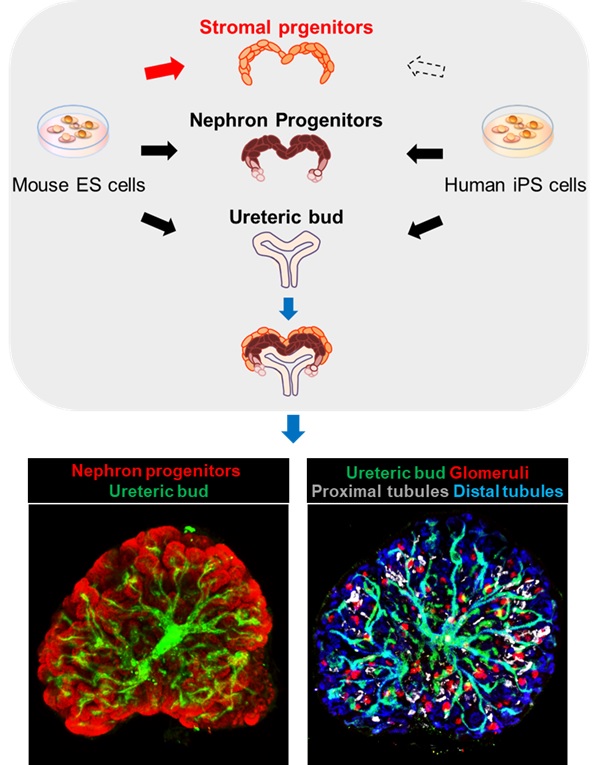
Shunsuke Tanigawa, Etsuko Tanaka, Koichiro Miike, Tomoko Ohmori, Daisuke Inoue, Chen-Leng Cai, Atsuhiro Taguchi, Akio Kobayashi, Ryuichi Nishinakamura. Generation of the organotypic kidney structure by integrating pluripotent stem cell-derived renal stroma. Nature Communications, 13:611, 2022.
doi.org/10.1038/s41467-022-28226-7
We have created complex 3D kidney tissue in the lab solely from cultured mouse embryonic stem (ES) cells. These organoids could lead the way to better kidney research and, eventually, artificial kidneys for human transplant.
By focusing on an often-overlooked tissue type of organoid generation research, a type of organ tissue made up of various support and connective tissues called the stroma, our team led by Prof. Ryuichi Nishinakamura (Department of Kidney Development, Institute of Molecular Embryology and Genetics (IMEG), Kumamoto University) were able to generate the last of a three-part puzzle that we had been working on for several years. Once the three pieces were combined, the resulting structure was found to be kidney-like in its architecture. We believe that our work will be used to advance kidney research and even lead to a transplantable organ in the future.
The kidney is a very important organ for continued good health because it acts as a filter to extract waste and excess water from blood. It is a complex organ that develops from the combination of three components. Protocols have already been established by various research teams, including ours, to induce two of the components (the nephron progenitor and the ureteric bud) from mouse ES cells.
In this, our most recent work, Shunsuke Tanigawa and Etsuko Tanaka in the team have developed a method to induce the third and final component, kidney-specific stromal progenitor, in mice. Furthermore, by combining these three components in vitro, we were able to generate a kidney-like 3D tissue, consisting of extensively branched ureteric buds and several other kidney-specific structures, such as glomeruli and renal tubules (Figure).
We believe that this is the first ever report on the in-lab generation of such a complex kidney structure from scratch. Our team has already succeeded in inducing the first two components from human iPS cells (Cell Stem Cell 2014, Cell Stem Cell 2017). If this last component can also be generated from human cells, a similarly complex human kidney should be achievable. We hope to use our developments to screen drugs for various diseases, and for transplantation in the long run.

Figure
We developed a protocol to induce stromal progenitors from mouse ES cells (red arrow) and combined them with nephron progenitors and a ureteric bud, which were also derived from ES cells (black and blue arrows), to produce kidney tissue with a higher-order structure in which nephron progenitors and nephrons (glomeruli and renal tubules) are arranged around branching ureteric buds. We have already reported the methods to induce nephron progenitors and ureteric buds from human iPS cells, and the development of a stromal progenitor induction protocol from human iPS cells is awaited (dotted arrow).